
Water is a critical resource for agriculture, but its scarcity and uneven distribution across regions and countries has become a major concern for farmers, policymakers, and water conservationists. The concept of virtual water trade in agriculture has emerged as a solution to mitigate water scarcity and promote sustainable agriculture. Virtual water trade refers to the transfer of water resources through the trade of agricultural products, which consume water during their production process.
Definition and Explanation of Virtual Water Trade:
Virtual water trade is the transfer of water resources through the trade of agricultural products. The virtual water concept was first introduced by Tony Allan, a British geographer, in the 1990s. According to Allan, "Virtual water is the amount of water required to produce a product, including the water used for growing crops, processing, packaging and transportation." In other words, virtual water refers to the hidden water content of a product, which is embedded in the production process and consumed at the source.
Historical Background and Evolution of Virtual Water Trade in Agriculture:
The concept of virtual water trade has evolved over the years, and its importance has been recognized by many experts in the fields of agriculture, water resources management, and environmental science. In the 1990s, Tony Allan first introduced the concept of virtual water, and since then, the concept has been widely researched and applied in different regions and countries. The virtual water trade has gained traction in recent years as a solution to water scarcity and water efficiency, especially in regions where water resources are scarce or subject to water stress.
Importance of Virtual Water Trade in Agriculture for Water Conservation and Efficient Water Use:
Virtual water trade in agriculture is crucial for water conservation and efficient water use. By trading in agricultural products, countries can conserve their own water resources and reduce the pressure on their water supplies. For example, a country that produces crops that consume large amounts of water, such as rice, can reduce its water consumption by importing products that have a lower water footprint, such as wheat. This way, the country can conserve its own water resources, which can be used for other purposes, such as drinking water, sanitation, and industrial use.
Virtual water trade can also help countries to reduce their water footprint and promote sustainable agriculture. By reducing the water footprint of their agricultural products, countries can conserve water resources and reduce the impact of agriculture on the environment. Moreover, virtual water trade can help countries to reduce their water stress and improve the water security of their populations.
How Virtual Water Trade Can Help Mitigate Water Scarcity in Agriculture:
Virtual water trade can help mitigate water scarcity in agriculture by promoting water efficient agriculture. By transferring water resources through the trade of agricultural products, countries can reduce their water consumption and conserve their own water resources. Moreover, virtual water trade can help to balance the distribution of water resources across regions and countries, thereby reducing water scarcity and improving water security.
Case Studies and Examples of Virtual Water Trade in Agriculture:
There are several case studies and examples of virtual water trade in agriculture from different regions of the world. One of the most notable examples is the virtual water trade between China and Australia. China is a major producer of rice, a crop that consumes large amounts of water, while Australia is a major producer of wheat, which has a lower water footprint. Through virtual water trade, China can import wheat from Australia, reducing its own water consumption and conserving its water resources for other purposes.
Another example of virtual water trade in agriculture is the trade between the United States and Mexico. The United States is a major producer of corn, a crop that consumes large amounts of water, while Mexico is a major producer of avocados, which require less water to grow. Through virtual water trade, the United States can export corn to Mexico while importing avocados, resulting in a more efficient use of water resources for both countries. This type of virtual water trade helps to reduce the pressure on water resources in regions where water is scarce, such as Mexico, and allows for the optimization of water use in regions where water is abundant, such as the United States.
This example shows the potential of virtual water trade in promoting sustainable agriculture and reducing the impact of water scarcity on food production. Virtual water trade allows countries to import high-water-consuming crops from regions with abundant water resources, reducing the need for water-intensive agriculture in regions where water is scarce.
Conclusion
In conclusion, virtual water trade in agriculture is a promising strategy for promoting sustainable agriculture and mitigating water scarcity. The concept of virtual water trade offers a way to conserve water resources and reduce the water footprint of agricultural products while ensuring food security and economic benefits. However, virtual water trade is not without challenges and further research is needed to fully understand its potential and limitations. Nevertheless, the potential benefits of virtual water trade make it a valuable tool for addressing the challenges of water scarcity and promoting sustainable agriculture in the future.





